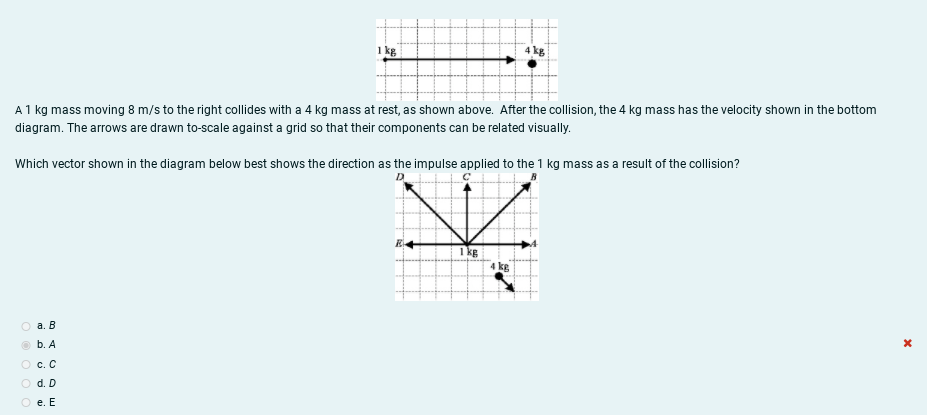1 kg 4 kg A 1 kg mass moving 8 m/s to the right collides with a 4 kg mass at rest, as shown above. After the collision, the 4 kg mass has the velocity shown in the bottom diagram. The arrows are drawn to-scale against a grid so that their components can be related visually. Which vector shown in the diagram below best shows the direction as the impulse applied to the 1 kg mass as a result of the collision? 1 kg а. В b. A O c. C d. D е. Е
1 kg 4 kg A 1 kg mass moving 8 m/s to the right collides with a 4 kg mass at rest, as shown above. After the collision, the 4 kg mass has the velocity shown in the bottom diagram. The arrows are drawn to-scale against a grid so that their components can be related visually. Which vector shown in the diagram below best shows the direction as the impulse applied to the 1 kg mass as a result of the collision? 1 kg а. В b. A O c. C d. D е. Е
Principles of Physics: A Calculus-Based Text
5th Edition
ISBN:9781133104261
Author:Raymond A. Serway, John W. Jewett
Publisher:Raymond A. Serway, John W. Jewett
Chapter8: Momentum And Collisions
Section: Chapter Questions
Problem 5OQ: A 5-kg cart moving to the right with a speed of 6 m/s collides with a concrete wall and rebounds...
Related questions
Question

Transcribed Image Text:1 kg
4 kg
A1 kg mass moving 8 m/s to the right collides with a 4 kg mass at rest, as shown above. After the collision, the 4 kg mass has the velocity shown in the bottom
diagram. The arrows are drawn to-scale against a grid so that their components can be related visually.
Which vector shown in the diagram below best shows the direction as the impulse applied to the 1 kg mass as a result of the collision?
1 kg
4 kg
а. В
b. А
O c. C
O d. D
O e. E
O O O O
Expert Solution
Formula
In collision,
There will be a momentum transfer happening.
As this is an elastic collision, there will be a transfer of momentum and the energy will be conserved.
So initial momentum ( Pi ) = m * u
where u is the initial velocity
and final momentum ( Pf ) = M * v
and v is the final velocity
( Pi ) = ( Pf )
Trending now
This is a popular solution!
Step by step
Solved in 2 steps

Knowledge Booster
Learn more about
Need a deep-dive on the concept behind this application? Look no further. Learn more about this topic, physics and related others by exploring similar questions and additional content below.Recommended textbooks for you

Principles of Physics: A Calculus-Based Text
Physics
ISBN:
9781133104261
Author:
Raymond A. Serway, John W. Jewett
Publisher:
Cengage Learning

Glencoe Physics: Principles and Problems, Student…
Physics
ISBN:
9780078807213
Author:
Paul W. Zitzewitz
Publisher:
Glencoe/McGraw-Hill

Physics for Scientists and Engineers: Foundations…
Physics
ISBN:
9781133939146
Author:
Katz, Debora M.
Publisher:
Cengage Learning

Principles of Physics: A Calculus-Based Text
Physics
ISBN:
9781133104261
Author:
Raymond A. Serway, John W. Jewett
Publisher:
Cengage Learning

Glencoe Physics: Principles and Problems, Student…
Physics
ISBN:
9780078807213
Author:
Paul W. Zitzewitz
Publisher:
Glencoe/McGraw-Hill

Physics for Scientists and Engineers: Foundations…
Physics
ISBN:
9781133939146
Author:
Katz, Debora M.
Publisher:
Cengage Learning

University Physics Volume 1
Physics
ISBN:
9781938168277
Author:
William Moebs, Samuel J. Ling, Jeff Sanny
Publisher:
OpenStax - Rice University


Classical Dynamics of Particles and Systems
Physics
ISBN:
9780534408961
Author:
Stephen T. Thornton, Jerry B. Marion
Publisher:
Cengage Learning